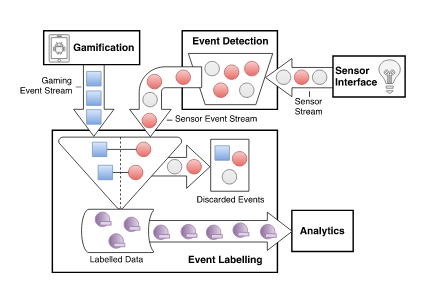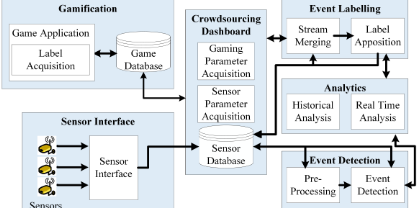ABSTRACT
The Internet of Things (IoT) enables connected objects to capture, communicate, and collect information over the network through a multitude of sensors, setting the foundation for applications such as smart grids, smart cars, and smart cities. In this context, large scale analytics is needed to extract knowledge and value from the data produced by these sensors. The ability to perform analytics on these data, however, is highly limited by the difficulties of collecting labels. Indeed, the machine learning techniques used to perform analytics rely upon data labels to learn and to validate results.
Historically, crowd sourcing platforms have been used to gather labels, yet they cannot be directly used in the IoT because of poor human readability of sensor data. To overcome these limitations, this paper proposes a framework for sensor data analytics which leverages the power of crowd sourcing through gamification to acquire sensor data labels. The framework uses gamification as a socially engaging vehicle and as a way to motivate users to participate in various labelling tasks. To demonstrate the framework proposed, a case study is also presented. Evaluation results show the framework can successfully translate gamification events into sensor data labels.
RELATED WORK
Sensor Data Labelling
To aid in the process of labelling, sensor data are often annotated with the activity surrounding the data reading. Activity recognition is a way of using sensors to identify activities and provide sensor context awareness to diverse applications. To achieve high accuracy in activity recognition tasks, researchers like Machado et al.and Roggen et al. used expensive methodologies such as human observers and video labelling respectively. However, these solutions cannot be adapted for automated labelling because of their dependence on third party labellers.
Gamification
The Gamification Summit defines gamification as “the use of game thinking and game mechanics to engage an audience and solve problems”. Many different techniques exist to implement gamification, all of which aim to creating a deep and long-lasting engagement among participants, non-game activities, and supporting organizations. Therefore, a key success criterion of gamification is whether the gaming features of an application enhance users’ internal motivation, enabling them to achieve their own goals.
GAMIFICATION FRAMEWORK

Fig. 1: Overview of the Gamification Framework
Figure 1 illustrates the main concepts of the framework. The central processing unit is built around two separate data streams: gaming events and sensor events. The gaming event stream is generated by users, who interact with the Gamification module by performing actions in a game application. The sensor event stream, on the other hand, is generated by the Event Detection module, which accesses the Sensor Interface to retrieve sensor data and identify events of interest. These two streams are sent to the Event Labelling module, which merges them and searches for correspondences between gaming and sensor events. By doing so, it associates data labels with the sensor readings and enables their use by Analytics.
Figure 2 depicts a more detailed view of the framework modules and their components. The following subsections discuss all modules in detail. The Crowd sourcing Dashboard is the central point of the framework and therefore interacts with every other module. It provides a means to capture the metadata needed by the framework, enabling the association between the sensor and gaming environments.
CASE STUDY
The case study presented here was developed in collaboration with Powersmiths, a company located in Brampton, Ontario, Canada, that develops meters for measuring various electrical features at a very short interval. Although they had been storing the data captured by these meters for a number of years, they still needed a labelled dataset to obtain actionable insights. This was an excellent opportunity to deploy the proposed framework and enable achievement of some of Powersmiths’ business objectives. Indeed, one of the company’s goals was to promote sustainability and reduce energy waste, and therefore the mobile game application was developed to engage users in energy-saving challenges.
- Game Application
- Analytics
- Implementation
EVALUATION
Setup
Over approximately four months, the framework was deployed to monitor the lighting events on the second floor of the Power smiths facility. The lights on the second floor were all monitored using a single device with multiple sensors, which provided the four readings used by the case study: the kW for each of the three current phases and the total kW consumption.
- Labelling Evaluation
- Evaluation of the Overall Framework
- Analytical Evaluation
CONCLUSION
The IoT aims to create a responsive environment where devices, humans, and software can seamlessly interact. However, knowledge and information must first be extracted from sensor data using analytics techniques such as machine learning. Machine learning relies on data labels: supervised learning needs them for training and unsupervised learning for validation. Although some data, such as images, can be relatively easily labelled by humans, users cannot simply look at sensor data and identify what activity the sensors are measuring.
This paper proposes a gamification framework for sensor data analytics. By translating sensor data into human readable gamification tasks, the framework enables data labels to be applied automatically, thereby improving sensor data analytics in the context of the IoT. In addition, use of gamification for crowd sourcing enables humans to become immersed within the entire process and encourages behaviour changes by engaging users to accomplish specific tasks. A case study demonstrated the use of the gamification framework for labelling electrical sensor data. The results showed that the framework can assign labels accurately to sensor data. Moreover, game users positively changed their behaviour, and these changes were reflected in the framework’s historical reports.
Future work will investigate adapting the gamification framework for Big Data to accommodate fully the needs of an IoT environment with a large number of sensors. The efficiency and applicability of the framework in more complex scenarios will also be evaluated.
Source: Western University
Authors: Alexandra L’Heureux | Katarina Grolinger | Wilson A.Higashino | Miriam A.M.Capretz
>> IoT based Big Data and Cloud Computing Projects for B.E/B.Tech Students
>> 200+ IoT Led Projects for Final Year Students
>> IoT Environmental Monitoring System for Smart Cities Projects for Final Year Students
>> IoT Software Projects for Final Year Students
